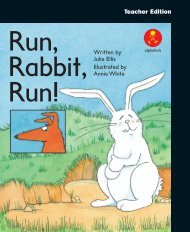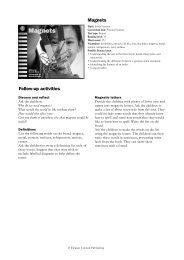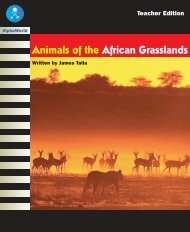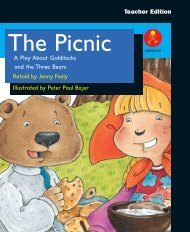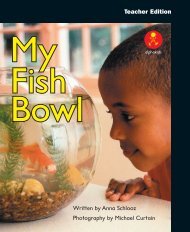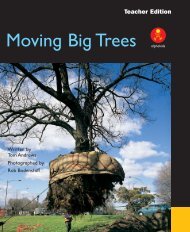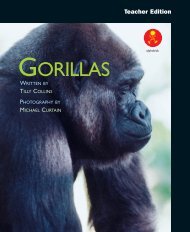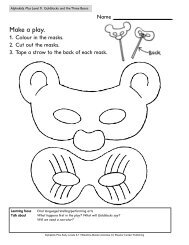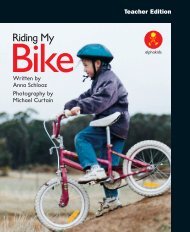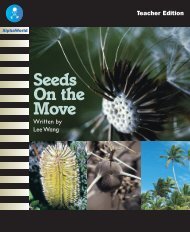Mighty Machines
Mighty Machines
Mighty Machines
Create successful ePaper yourself
Turn your PDF publications into a flip-book with our unique Google optimized e-Paper software.
Teacher Edition<strong>Mighty</strong>alphakids<strong>Machines</strong>Written byHannah Reed
Published edition© Eleanor CurtainPublishing 2004First published 2004Apart from any fair dealing forthe purposes of study, research,criticism or review, aspermitted under the CopyrightAct of Australia, no part of thisbook may be reproduced byany process, or transmitted inany form, without permissionof the copyright owner. Wherecopies of part or the whole ofthis book are made under PartVB of the Copyright Act, thelaw requires that records ofsuch copying be kept and thecopyright owner is entitled toclaim payment.Developed byEleanor Curtain PublishingText: Kerrie ShanahanConsultant: Susan HillDesigned byAlexander StittProduction byPublishing SolutionsPrinted in ChinaISBN 0 7253 3386 31 2 3 4 5 6 7 8 904 05 06?How to use this bookBefore reading: TalkthroughTalk through the book with the children. Encouragethem to predict the text from the cover and thepictures, and to think about the information theyprovide. Direct the children’s attention to aspects ofthe text that may challenge them. Support the childrento deal with these challenges by asking theTalkthrough questions on each page.During reading: Observe and supportObserve the children as they read. Encourage themto monitor their own reading as they comprehendthe text. As needed, support the children by helpingthem to discover and use reading strategies and cuesto solve problems and respond to reading challengesthat arise in the text. Interruptions to the children’sreading should be minimal and focused on specifiedlearning needs.After reading: Comprehension, returning tothe text, responding and writing linksTo further develop children’s understanding of thetext, select from activities found on page 16 and theinside back cover. These whole text, sentence and wordlevel activities reinforce the teaching focus of thisbook. Assessment ideas are provided to assist withplanning for further teaching.Text highlights• The text is repetitive and uses the sentenceform: ‘This machine is used to … It can …’• A pictorial index is provided.Vocabularybreak, carry, drill, fight, heavy, lift, machines,mighty, move, work
Setting the contextWhat do you think a mighty machine is?What type of machines might be mightymachines?List the children’s suggestions on a chartunder the headings: ‘Machine’ and ‘Whatwork it does’Introducing the bookThis is a book about very large machinesand the work they do.Front coverThis book is called <strong>Mighty</strong> <strong>Machines</strong> .Have you seen a machine like this before?Tell me about it.Title pageDraw the children’s attention to thephotograph.This picture shows part of a machine. Whatcould it be?
<strong>Mighty</strong> <strong>Machines</strong> Pages 2–3?TalkthroughThese pages show some different kinds of machines. Whatare the machines doing?How are the machines helping the people?Observe and supportCan the children understand the literal meaning of thetext?Are there different types of machines?What do people use machines for?What type of things can machines do?2
<strong>Mighty</strong> <strong>Machines</strong> Pages 4–5?TalkthroughHere is a machine that carries logs. What is it called?How could these logs be moved if there were no trucks?Observe and supportDo the children search for a range of information on thepage to support their reading?I noticed that you looked at the picture before you read thispage. What were you looking for? How did it help?I liked the way you used the picture to help with the word‘logs’. What else could you have checked to help work outthis word?4
<strong>Mighty</strong> <strong>Machines</strong> Pages 6–7?TalkthroughHere is a machine that moves rocks and dirt. Have you everseen a machine like this? What was it doing?Observe and supportCan the children make inferences from the text andphotographs?Is this machine important to people? Why?How would people do this work if this machine hadn’t beeninvented?6
<strong>Mighty</strong> <strong>Machines</strong> Pages 8–9?TalkthroughWhat are these machines doing? What are they breaking up?Do you know of any other, similar machines?Observe and supportDo the children use a range of strategies to work out newvocabulary?How did you work out the word ‘concrete’? What else couldhave helped you with this word?If a child is having difficulty, you might ask:What is the machine doing in the picture? What letter doesthe word start with? What sound might this letter make? Canyou see a smaller word that you know in the word concrete?8
<strong>Mighty</strong> <strong>Machines</strong> Pages 10–11?TalkthroughWhat do you think this machine is used for?Who is in the machine? How would you feel if you were thefirefighter?Observe and supportDo the children read the text clearly so that it is easy tounderstand?Well done. I could easily understand the information youread on that page.10
<strong>Mighty</strong> <strong>Machines</strong> Pages 12–13?TalkthroughThis machine is drilling a hole in the ocean floor. What doyou think it is drilling for?Observe and supportCan the children use phonic understanding to work outnew words, such as ‘drill’?12
<strong>Mighty</strong> <strong>Machines</strong> Pages 14–15?TalkthroughThis machine can lift heavy things. What is it lifting?Do you know what these machines are called?Observe and supportCan the children use the text and photographs tounderstand the literal meaning of the text?What does this machine do? How did you know that? Isthere anything else on the page that could have told youthat? What does the machine lift?14
<strong>Mighty</strong> <strong>Machines</strong> Page 16?TalkthroughWhat is an index for? What do the numbers mean?On what page can you find information about machines that breakthings?What information is found on page 4?Why are there two page numbers next to ‘machines that lift things’?16After readingBeing a meaning makerEncourage the children to support their answers with evidencefrom the book as they discuss these comprehension questions:Which machines can move things?Which machines can lift things?What else can some of the machines do?How would people get their work done without these machines?
Being a code breakerExplore the following language features:• High-frequency words: are, can, do,for, is, it, of, there, this, to.• Words that rhyme with ‘can’: ban,fan, ran, van, tan.• Hearing sounds: The children couldbe asked to raise a finger each timethey hear the sound /sh/ as the textis read to them.Being a text userRefer to the text when discussing thesequestions:When do you use an index?How do you use an index?What sorts of books have an index?Being a text criticWhat did the author need to know to write thisbook?Which machines has she included?Which machines has she left out?Would you like to have seen any othermachines included? If so, which ones?Responding to textEncourage the children to useconstruction materials such asLego to build a machine. When they havefinished, they could talk about theirmachines to the rest of the group,explaining what work their machine does.The children may like to maketheir own mighty machinesencyclopedia. This could be modeled onthe sentence forms used in the book:‘This machine is used to ... It can …’Make a list of all the verbs ordoing words in the book (carry,move, break, lift, drill). Ask the childrento add to the list.WritingWrite out the sentence stems from thebook onto a chart: ‘This machine is usedto … It can …’ Choose a page from thebook and cover the text with paper. Invitethe children to finish the sentences.Discuss their spelling strategies.I like the way you represented two syllables inthe word ‘carry’. You have an ‘e’ at the end ofthe word ‘carry’. Do you know another letterthat sometimes makes the /e/ sound?AssessmentCan the children:• use an index to find out about machines that drill things?• explain why people use machines?whole text activity sentence activity word activity
alphakids<strong>Mighty</strong><strong>Machines</strong>Written byHannah ReedTeacherEditionOtherbooksat thislevelMaking aPicturealphakidsWritten bySara OldfieldPhotography byMichael CurtainTopic: <strong>Machines</strong>Curriculum link: Science/TechnologyText type: ReportReading level: 6Word count: 82High-frequency words: are, can, do, for, is, it, of,there, this, toVocabulary: break, carry, drill, fight, heavy, lift,machines, mighty, move, workPossible literary focusUnderstanding literal information.Using an index to locate specific information.alphakidsDress- upsWritten bySara OldfieldPhotography byMichael CurtainMy FarmalphakidsWritten by Jack HastingsPhotography by Michael CurtainRun,Rabbit,Run!Written byJulie EllisIllustrated byAnnie WhitealphakidsSummaryThis book focuses on a range of very large machinesand the work they do.ISBN 0- 7253- 3386- 39 780725 333867alphakids



